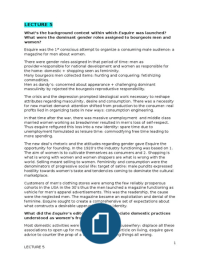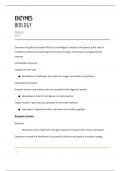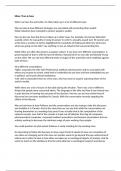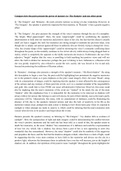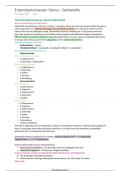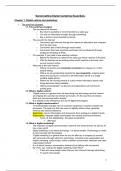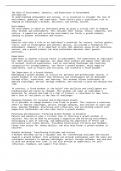LECTURE 5
What's the background context within which Esquire was launched?
What were the dominant gender roles assigned to bourgeois men and
women?
Esquire was the 1st conscious attempt to organize a consuming male audience: a
magazine for men about women.
There were gender roles assigned in that period of time: men as
provider+responsible for national development and women as responsible for
the home: domestic + shopping seen as femininity.
Many bourgeois men collected items: hunting and conquering: fetishizing
commodities.
Men as dandy’s: concerned about appearance + challenging dominant
masculinity by rejected the bourgeois reproductive responsibility.
The crisis and the depression prompted ideological work necessary to reshape
attributes regarding masculinity, desire and consumption. There was a necessity
for new market demand: attention shifted from production to the consumer: real
profits lied in organizing taste in new ways: consumption engineering.
In that time after the war, there was massive unemployment and middle class
married women working as breadwinner resulted in men’s loss of self-respect.
Thus esquire refigured this loss into a new identity: spare time due to
unemployment formulated as leisure time: commodifying free time leading to
more spending.
The new deal’s rhetoric and the attitudes regarding gender gave Esquire the
opportunity for founding. In the 1920’s the industry functioning was based on 1.
The aim of women is to cultivate themselves as consumers and 2. Shopping is
what is wrong with women and women shoppers are what is wrong with the
world. Selling meant selling to women. Femininity and consumption were the
denominators of progressive social life: target of satire: male pundits expressed
hostility towards women’s taste and tendencies coming to dominate the cultural
marketplace.
Customers of men’s clothing stores were among the few reliably prosperous
cohorts in the USA in the 30’s thus the men launched a magazine functioning as
vehicle for men’s apparel advertisements. This was the readership, the cause
were the neglected men. The magazine became an exploitation and denial of the
feminine. Esquire sought to create a comprehensive set of expectations about
what constructs a desirable upper-middle class identity.
What did the Esquire’s editorial do to disassociate domestic practices
understood as women’s from women?
Most domestic activities were associated with the housewifery: displace all these
associations to open up for male readers. In every article on living, esquire gave
advice to counter the prop of a woman who is doing things all wrong.
1
LECTURE 5
, Women were described to have an awful taste in food, home and drinks. Women
were portrayed as incompetent housewives who it too emotional and cannot
cook. Esquire gendered the meaning of good and bad taste. Men’s style was
seen as clean, functional, machine-based design, innovation itself. And women’s
style was seen as appearance over comfort, awful, anti-alcohol, man hating,
prudish. They came up with powerful negative feminine stereotypes relating to
the domestic domain as well. Esquire’s willingness to tout alcoholic beverages
made those industries rise up and be important advertisers.
Esquire’s how to consuming desire: no place for women: seen as foul against
which a superior male taste could be posited. The fact that women had distaste
in everything according to Esquire relationally influenced the way the men had to
behave himself. This provided class appropriate behaviour: Esquire presented
numerous commentaries on manners and mores to set new standards and
values for the bourgeoisie as the targeted readership. Femininity was posited to
be of bad taste and boorish behaviour/suspect inventions.
Esquire’s notions of taste, gender, consumption and identity radically subverted
assumptions about femininity and masculinity + structure of periodically
industry: separate gender roles due to taste and women as having no legitimate
role to play.
Feminitity was marketed as a lack and this together with the fact that there was
an exploitation and denial of the feminine led to the claiming of male privilege.
Esquire kept intact heterosexuality.
Women’s inequality was justified: Natural component theory: men and women do
not compete with one another. The men’s role was in the public sphere, the
women’s role in the private sphere. One was either masculine or feminine: binary
gender roles.
New domestic scenario: progress for both women and men and with as mutual
enemy the domestic femininity.
How did the the Esquire’s editorial transform male consumers from
voyeurs to connoisseurs?
Esquire’s pictorial content offered its male audience what amounted to a system
of control devised around the sexual gaze and attuned to modern bourgeois
sensibilities. The text worked to deny the legitimacy of social roles proceeding
from sexual difference, illustrations provided the site to which difference could be
positioned. Text: displace archetype of consuming femininity. Pictures: deny
homosexuality: women as the reader’s desire thus erotic coding.
It was the first time images were presented to be consumed on their own:
distancing meaning of texts and visuals. Playing of this contrast: sexy visuals
exploited as well as they stayed invisible in a sense. Esquire’s identity as a set of
overlapping contrasts: texts vs. visuals, male vs female etc.
Women were either represented as fine art or pin up girl: the petty girl: blonde,
large breasts, small waist and buttocks, long and slender legs: the Caucasian
2
LECTURE 5
What's the background context within which Esquire was launched?
What were the dominant gender roles assigned to bourgeois men and
women?
Esquire was the 1st conscious attempt to organize a consuming male audience: a
magazine for men about women.
There were gender roles assigned in that period of time: men as
provider+responsible for national development and women as responsible for
the home: domestic + shopping seen as femininity.
Many bourgeois men collected items: hunting and conquering: fetishizing
commodities.
Men as dandy’s: concerned about appearance + challenging dominant
masculinity by rejected the bourgeois reproductive responsibility.
The crisis and the depression prompted ideological work necessary to reshape
attributes regarding masculinity, desire and consumption. There was a necessity
for new market demand: attention shifted from production to the consumer: real
profits lied in organizing taste in new ways: consumption engineering.
In that time after the war, there was massive unemployment and middle class
married women working as breadwinner resulted in men’s loss of self-respect.
Thus esquire refigured this loss into a new identity: spare time due to
unemployment formulated as leisure time: commodifying free time leading to
more spending.
The new deal’s rhetoric and the attitudes regarding gender gave Esquire the
opportunity for founding. In the 1920’s the industry functioning was based on 1.
The aim of women is to cultivate themselves as consumers and 2. Shopping is
what is wrong with women and women shoppers are what is wrong with the
world. Selling meant selling to women. Femininity and consumption were the
denominators of progressive social life: target of satire: male pundits expressed
hostility towards women’s taste and tendencies coming to dominate the cultural
marketplace.
Customers of men’s clothing stores were among the few reliably prosperous
cohorts in the USA in the 30’s thus the men launched a magazine functioning as
vehicle for men’s apparel advertisements. This was the readership, the cause
were the neglected men. The magazine became an exploitation and denial of the
feminine. Esquire sought to create a comprehensive set of expectations about
what constructs a desirable upper-middle class identity.
What did the Esquire’s editorial do to disassociate domestic practices
understood as women’s from women?
Most domestic activities were associated with the housewifery: displace all these
associations to open up for male readers. In every article on living, esquire gave
advice to counter the prop of a woman who is doing things all wrong.
1
LECTURE 5
, Women were described to have an awful taste in food, home and drinks. Women
were portrayed as incompetent housewives who it too emotional and cannot
cook. Esquire gendered the meaning of good and bad taste. Men’s style was
seen as clean, functional, machine-based design, innovation itself. And women’s
style was seen as appearance over comfort, awful, anti-alcohol, man hating,
prudish. They came up with powerful negative feminine stereotypes relating to
the domestic domain as well. Esquire’s willingness to tout alcoholic beverages
made those industries rise up and be important advertisers.
Esquire’s how to consuming desire: no place for women: seen as foul against
which a superior male taste could be posited. The fact that women had distaste
in everything according to Esquire relationally influenced the way the men had to
behave himself. This provided class appropriate behaviour: Esquire presented
numerous commentaries on manners and mores to set new standards and
values for the bourgeoisie as the targeted readership. Femininity was posited to
be of bad taste and boorish behaviour/suspect inventions.
Esquire’s notions of taste, gender, consumption and identity radically subverted
assumptions about femininity and masculinity + structure of periodically
industry: separate gender roles due to taste and women as having no legitimate
role to play.
Feminitity was marketed as a lack and this together with the fact that there was
an exploitation and denial of the feminine led to the claiming of male privilege.
Esquire kept intact heterosexuality.
Women’s inequality was justified: Natural component theory: men and women do
not compete with one another. The men’s role was in the public sphere, the
women’s role in the private sphere. One was either masculine or feminine: binary
gender roles.
New domestic scenario: progress for both women and men and with as mutual
enemy the domestic femininity.
How did the the Esquire’s editorial transform male consumers from
voyeurs to connoisseurs?
Esquire’s pictorial content offered its male audience what amounted to a system
of control devised around the sexual gaze and attuned to modern bourgeois
sensibilities. The text worked to deny the legitimacy of social roles proceeding
from sexual difference, illustrations provided the site to which difference could be
positioned. Text: displace archetype of consuming femininity. Pictures: deny
homosexuality: women as the reader’s desire thus erotic coding.
It was the first time images were presented to be consumed on their own:
distancing meaning of texts and visuals. Playing of this contrast: sexy visuals
exploited as well as they stayed invisible in a sense. Esquire’s identity as a set of
overlapping contrasts: texts vs. visuals, male vs female etc.
Women were either represented as fine art or pin up girl: the petty girl: blonde,
large breasts, small waist and buttocks, long and slender legs: the Caucasian
2
LECTURE 5


